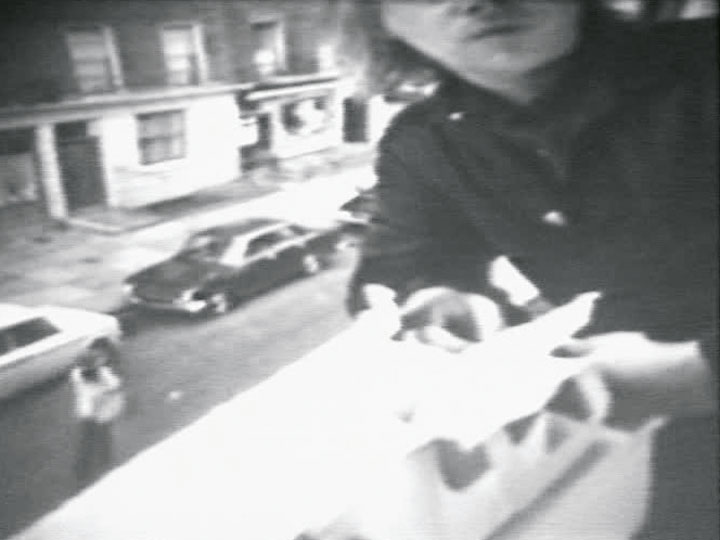
photo : © Askevold-Ready Studio, permission de | courtesy of Musée des beaux-arts de la Nouvelle-Écosse, Halifax
David Askevold’s video Learning About Cars and Chocolates (1972) stages a strange conversation. It is a conversation with strict parameters, designed to highlight and synchronize two flows of objects that pass through a scene.
The camera reveals Askevold’s torso and the lower part of his face in the upper right of the frame, facing more or less toward the viewer. In front of him is a pound of chocolates purchased from a specialty confectionery; beside him, an open window looks down onto a London street. Each time a car goes by, he asks: “What colour was that car? ” or “What kind of car was that? ” A voice answers from outside the frame: “That car was navy blue,” or perhaps: “That was brown, sort of a shoe-leather brown.” (The voice is Jack Wendler’s, Askevold’s London gallerist.) Askevold responds by biting into a chocolate and describing it to Wendler: “This one is white. There’s definitely a strong vanilla flavour, and there’s a little bit of pineapple in it, and little bits of nuts. I’m not sure what kind of nuts they are.”1 1 - All quotations in this description from Learning About Cars and Chocolates, by David Askevold (Toronto: Vtape, 1972), videocassette, 20:42. Special thanks to Wanda Vanderstoop at Vtape and Jonathan Newman at the National Gallery of Canada for their kind assistance in locating and accessing the video. He continues to ask mundane questions about the car’s mileage, cost, popularity, drivers, or speed, which Wendler obligingly answers until the next car comes around. Then, the cycle begins again: “What colour was that car? ”
Askevold maintains a 1:1 ratio of cars to chocolates, turning the traffic into a time signature for his consumption. A few times, when the cars whiz by one after the other, he barely has time to bite into the chocolates and his gestures are hurried. At other times, the pace is much slower; there’s a sense of struggling to fill up the time until, very abruptly, the next car goes by, cutting off the last line of questioning with a very similar one. This strange discussion goes on for about twenty minutes, until the chocolates are gone and Askevold ends the exchange with: “I’m out of chocolates. I think that’ll be enough. Okay? Thank you.”
This is a work about which, unfortunately, relatively little has been written. Yet it highlights epistemological questions about the agency of objects with unusual clarity. Learning examines the extent to which objects (and particularly commodities) can produce the very terms through which our attention is drawn toward them. Yet this very act of questioning puts the objects themselves into question, portraying perception as a tenuous, partial, and ever-changing grasp on the things it perceives. Here, objects produce an ongoing rhythmic interchange between perceptual and conventional understanding.
An ekphrastic poem of sorts, Learning About Cars and Chocolates extends sensation into language, into distance, into signs. Language extends the reach of the senses, but in doing so, it reduces the picture. We see other actions that never make it into Wendler’s description of the street. A cat wanders through the scene, a plane goes by, a man crosses the street, the wind whips through Askevold’s hair. These excesses bear witness to the arbitrariness of the video’s premise, and to the necessary reductiveness of building an understanding.
Reductiveness aside, this work nonetheless portrays quite a complex set of relations: two congruent flows of commodities, illuminated by various senses and rendered in so many signs. In the conversation between Askevold and Wendler, two sensoria (succinctly focused) come into lockstep. Askevold’s description of the chocolates fills in for what Wendler can’t taste; Wendler’s words fill in for what Askevold can’t see (humourously enough, since it seems it would be very easy for him to look out the window if he wanted to). This scenario extends the individualistic limits of the sensoria; the body widens its cone of vision through borrowed eyes, lengthens the reach of its taste buds through dialogue. Sensation, here, is conceived not as a property of an individual body, but as awash with bodies, pinging between them, encrypted and translated at every turn. Nervous system, language and video: all are technologies for transforming sensation into sign.
A temporal flow links the two subjects to the flow of objects in a narrated present. Suspended in this present, Askevold’s and Wendler’s perceptions do not cover swaths of “neutral” space so much as they gather around objects, lured by their movement, their conspicuousness, and the hum of interest that they carry through the scene. The cars and chocolates — fetishized though familiar objects — march on analogously to objects on a factory line. The bland regularity of consumer experience reflects the bland regularity of industrial production techniques. But it’s not a perfect mirror; the cars come at a staggered rhythm. This irregular rhythm partly reflects the traffic regulations’ tidal influence on the spacing of cars, and partly records the whim or will to travel at a remove, from a sociological rather than personal perspective. The idea of personal will comes in as a wedge, and is felt as a rhythm.

captures vidéo | video stills, 1972.
photos : © Musée des beaux-arts du Canada, Ottawa,
permission de | courtesy of Askevold-Ready Studio
Dépôt de la collection vidéographique d’Art Metropole,
Toronto, 1997
In becoming a consumer, one must often make do with the readymade language of consumption, “taking it in” and allowing it to speak on one’s behalf. The very idea of having a complex (and even conflicted) interior life can be linked to the rise of commodity culture. In nineteenth-century British literature, for instance, characters were imbued with internal complexity to an unprecedented extent. Deidre Shauna Lynch argues that such characters helped readers to navigate newly commoditized social relations. With a massive influx of newly available imports in Britain, consumers, she argues, needed to learn how to turn these alien objects into private possessions. Literary characters functioned as “social technologies”2 2 - See Deidre Shauna Lynch, The Economy of Character: Novels, Market Culture and the Business of Inner Meaning (Chicago: University of Chicago Press, 1998), 11. which allowed their users to do just that. Refashioning their own inwardness, readers learned to differentiate themselves from others by relating to highly differentiated characters, thus aligning themselves with the subjective demands of the emerging consumer economy.
If the characters Lynch describes offer lessons in interiority, Askevold offers the opposite: a demonstration of various means through which to hold interiority at a remove. While the chocolates Askevold tries are, of course, made to be literally taken in to the body (drawing a path through its interior), here they are only half consumed; the artist takes a bite and discards the rest. The cars — reduced in size perspectivally so they are not much bigger on screen than the chocolates — are themselves interiors, taking their passengers in and, reciprocally, allowing them to take their bubble of private space beyond the home, into the street. But here they encounter an attention that lets them pass more or less indifferently. This video never gives us the interior complexity of a character. If anything, it is the objects themselves which possess an interiority — one which speaks to, but also goes beyond that which Lynch describes. The cars and chocolates bear witness to the rhetorical production of internal life in consumer experience (in the form of the alienated consumer subject). But they also seem imbued with their own internal force, an agency of matter. As Charles Sanders Peirce puts it: “Viewing a thing from the outside, considering its relations of action and reaction with other things, it appears as matter. Viewing it from the inside, looking at its immediate character as feeling, it appears as consciousness.”3 3 - Charles Sanders Peirce, “The Law of Mind,” in Philosophical Writings of C. S. Peirce, ed. Justus Buchler (New York: Dover, 2000, 339-353): 353.
In order to be affected by matter’s consciousness, Askevold and Wendler render themselves somewhat mute. As viewers, we come to know something of the affective tenor of the two men’s friendship. With a little outside reading, we might also identify the two characters as artist and gallerist. These are sparse, apersonal designations: stereotypes, or as Deleuze and Guattari would call them, psychosocial types.4 4 - See Deleuze and Guattari, What is Philosophy?, trans. Hugh Tomlinson and Graham Burchell(New York: Columbia University Press, 1996), 62-5. In short, we can learn of Askevold and Wendler’s respective dispositions and positions (in relation to each other and to their society, respectively), but not of them. They use nothing but the most mundane, clichéd language to portray a minimal range of predictable decisions. They wield attention, perception, and language according to a readymade premise, translating the experience of objects from one medium to another. They are “social technologies” producing disinterested attention — a fine art (or even flaneurian) model for aesthetic appreciation displacing that of the desirous consumer.
The camera catapults the scene into the future, opens the dialogue to a third perceiver. Like Manet’s A Bar at the Folies-Bergère (1882), the image places us in a similar-but-not-identical spatial and rhetorical role as the absent figure of Jack Wendler (who is present only through his voice). Like the man at the Folies-Bergère, Wendler (as Askevold’s gallerist) is a patron, and, presumably, faces the artist with a somewhat desirous, certainly friendly, obliging attention. Like Wendler, the viewers oblige the piece’s premise with their attention. And they add another incomplete sensory picture to the pile, for their video vision lacks something that both Askevold’s and Wendler’s speech continuously fills in for: colour.
When it comes to commodities, colour may be a matter of sight, but it’s also a matter of taste. When choosing from a relatively homogenous, relatively little understood set of differences (how does one motor’s manufacture compare with another?), colour personalizes the decision, allowing one to assimilate the new object into a caricaturized spectrum of personal fancy. The cars’ colours — “robin’s-egg blue” or “shoe-leather brown” — act as shorthand for personal taste; yet they are also mnemonics, layering “natural” material resonances onto the purview of cars. The colour funnels the car into another imaginary object-spectrum, which is also the imaginary spectrum of consumer taste.
Producing a complex scenario for witnessing the everyday, Askevold’s video widens the scope of this arbitrary constitution of consumer choice. Leaking an aberrant form of sensory engagement into the mundane language of commodities, it aims to show how permeable this ostensibly closed system can be. It offers disinterestedness — a certain unaffected attention, an attitude ascribed to pedagogy and art appreciation — as an antidote to this closed, subjectified, desirous symbolization. Or is this disinterestedness simply an imaginary outside which allows subjection to function?
This question remains unanswered, but it is, at the very least, addressed to someone. Through video, the objects — and the conversations that house them — produce for themselves a future witness, an unknown spectator to whom their presence can be addressed as they move through a London neighbourhood in 1972.



